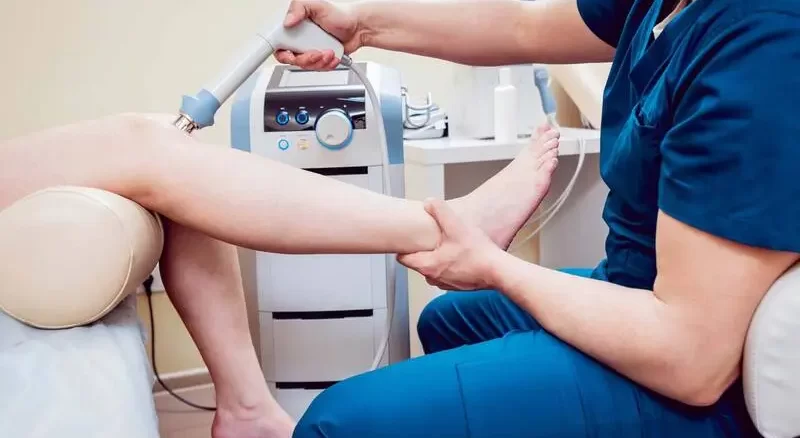It may be a question for everyone what the benefits of physiotherapy are and what role it plays in relieving pain and treating diseases and disorders.
Physiotherapy is one of the most sensitive and important tasks, including initial examination, diagnosis, treatment planning, interventions, and evaluation. Physiotherapy needs to be performed by or under the supervision of a physiotherapist to see its benefits.
Physiotherapists consider physiotherapy a very suitable treatment method that can be used to treat various diseases. They also believe that the benefits of physiotherapy are very high and the risk is very low.
In this article, you’ll learn what physiotherapy is, its benefits, and the use of this treatment method.
What Is Physiotherapy?

Physiotherapy is one of the main branches of rehabilitation science and falls under the rehabilitation category.
The main purpose of physiotherapy treatment is to:
- Improve function
- Boost range of motion
- Enhance muscle strength, muscle flexibility, and muscle endurance
- Improve life.
- Facilitate walking
- Enrich the overall function.
Everything related to human movement is related to physiotherapy and can be involved. The physiotherapist designs a treatment plan for patients using the science of anatomy, and physiology, recognizing diseases, and the resulting motor complications. This treatment plan includes the following:
- Exercise therapy to improve patients’ mobility
- Manual therapies
- Using special tools, electrotherapy devices
- Applying equipment needed to help patients recover.
✔️ Read More: Haglund’s Deformity; How To Diagnose and Treat It
How Do Physiotherapists Help Patients?

The physiotherapist thoroughly assesses the patient’s condition while patiently listening to the patient’s problems.
He first observes the patient’s condition, then touches and examines the affected area. A temporary diagnosis is made after this examination.
Afterward, physiotherapists will plan the treatment and prepare a home exercise diet to strengthen the muscles.
They teach patients the precautions that need to be taken to resolve the problem. They also advise patients.
The physiotherapist teaches the activities needed to move patients who cannot get out of bed, such as spinal cord injury patients.
They focus on muscle retraining and the control and rehabilitation of small and large movements in diseases such as cerebral palsy, spinal cord injury, MS, Parkinson’s disease, brain injury, and stroke.
✔️ Read More: What Is a Ligament? Types of Ligaments and the Causes of Their Injury
Who Needs Physiotherapy?

The science of physiotherapy, as mentioned, considers all the diseases that are related to movement and everything that is needed to move. Therefore, it includes several categories of diseases. In fact, those who need physiotherapy include patients with the following diseases.
Physiotherapy in Orthopedic Patients
The most important category in which physiotherapy is used is the category of orthopedic patients. It is useful and practical for all patients, including those with spine and musculoskeletal problems.
Physiotherapy in Neurological Patients
This physiotherapy includes patients who are in the field of neurology. In fact, this treatment includes diseases that are related to the nervous system and affect the movement of people, such as:
- MS
- Parkinson
- stroke
- Concussion
- Spinal cord injuries
Physiotherapy in Respiratory and Cardiac Patients
Physiotherapy is also used for respiratory and heart diseases. It’s important in heart disease patients because it affects a person’s performance and improves respiratory and cardiac capacity.
Some of its benefits and purposes for respiratory and cardiac patients include:
- Lung capacity improvement
- Respiratory status improvement
- The respiratory muscles strengthen
- Cardiac rehabilitation
Physiotherapy in Rheumatic and Cutaneous Patients
The next diseases for which physiotherapy can be very effective are rheumatic and skin diseases.
Rheumatic diseases are a group of autoimmune diseases that mainly affect the body’s joints. In addition, they can affect other parts of the body, but the most important places are the joints that directly affect movement.
Physiotherapy can also be effective for several skin conditions that restrict movement (such as scleroderma).
Pelvic Physiotherapy
Physiotherapy can also help with pelvic problems, including:
- Women’s diseases
- Diseases of men
- Sexual problems
- Urinary and fecal incontinence problems
- Any problems that are related to the pelvic and genitals
Physiotherapy in Hospitalized Patients
Physiotherapy can also be effective in conditions such as after pregnancy and surgery. People who give birth or undergo surgery definitely need it.
In fact, these cases are among the problems that physiotherapy can solve in patients who need hospitalization.
Physiotherapy for Burn Patients
Other diseases that physiotherapy can affect are burn patients.
In fact, patients with burns have damaged their skin, and the soft tissue condition may change dramatically, and it may become short. Excess flesh or scar tissue that builds up may also restrict joint movement.
For this reason, patients who suffer from burns will definitely need physiotherapy.
Pediatric physiotherapy
Another group of patients who need physiotherapy is children. Diseases in children are related to congenital problems or problems that occur in infancy. Therefore, physiotherapy can help these people as well.
Some of these are:
- Orthopedic problems
- Neurological problems
- Cognitive problems
✔️ Read More: What Is a Tendon? Types of Tendons and the Causes of Their Damage
What Are the Types of Physiotherapy Methods?

Before you see a physiotherapist, the process begins with a doctor’s prescription. Your specialist will also make a difference, depending on the type of problem you have.
For example, if a person has problems with fractures or bruises, the orthopedist will prescribe physiotherapy. Also, if a stroke has caused movement problems, the neurologist will be responsible. After doing this and continuing this process, the patient should refer to a physiotherapist. By examining him at this stage, the doctor can determine the number of sessions required and the type of treatment techniques.
In general, many practical techniques are involved in the physiotherapy process, some of the most important of which are as follows:
Wave Therapy
It is one of the most practical physiotherapy techniques in which ultrasound waves are used to treat and improve the patient’s condition. Some major problems, such as inflammatory problems, fractures, sprains, joint and muscle problems can be eliminated because of the greater penetration depth that ultrasound creates.
Tennessean Therapy (TENS)
Another highly regarded area in physiotherapy is the use of electrical stimuli and tens. This method’s main application is in treating problems related to damaged muscles.
Exercise Therapy
It is safe to say that exercise therapy is one of the oldest and, of course, the most useful methods and techniques of physiotherapy. In most cases, this method does not require complex equipment or costs. An important point in exercise therapy is the specialty of the physiotherapist and the information he has about the various exercise techniques. The more specialized a physiotherapist is, the simpler, more attractive, and more effective the movements will be for the client.
✔️ Read More: Joint peroneal nerve entrapment – diagnosis and treatment
Massage Therapy
You may be interested to know that specialized massage is one of the main subsets of physiotherapy. The main action of massage, which helps with many problems, is to create balanced circulation in the body’s tissues.
On the other hand, people with tissue and muscle problems can significantly improve their problems by receiving specialized massage.
Heat Treatment
The unique feature of heat is that it can improve blood circulation in that area when it’s concentrated at a certain point. In physiotherapy, heat is used for the same purpose. Of course, this method also uses heat to relieve muscle cramps.
Benefits and Side Effects of Physiotherapy

All applied methods in medical science have their own advantages and disadvantages. Also, most of the drugs we take may be very useful and necessary for some parts of the body, but they can also damage other parts.
In any case, the doctor determines what and how to get help in each case. However, it seems necessary to mention that basic and specialized physiotherapy usually doesn’t have any special side effects. The side effects of physiotherapy, which we will mention in the following, are the side effects that may be seen in a person in the direction of unprincipled and unprofessional physiotherapy.
We will first look at the main benefits of physiotherapy.
Benefits of Physiotherapy
The benefits of physiotherapy are as follows:
Raising the life expectancy of people
Certainly, mobility problems, disabilities, long-term physical injuries, and other similar cases will negatively affect patients and injured people. Some of these problems take a person away from society to a large extent and form a feeling of worthlessness and hopelessness in him.
Physiotherapy, without any exaggeration, has increased the life expectancy of these people hundreds of times. The slightest sign of treatment in these people makes them much more motivated to follow their treatment process, which in the long run will increase their life expectancy and thus their full recovery.
✔️ Read More: Examine the causes of flat feet and the best way to treat it!
Helping Athletes
Many professional athletes can perform better in their sports with the help of effective physiotherapy techniques. In addition, any sports injuries can be treated very quickly with the help of physiotherapy.
Reduce Surgery
It may also be worth noting that the number of superficial and almost unnecessary surgeries can be reduced by performing physiotherapy and resolving each person’s problems. This can play an important role in human health.
Reduce the Damage of Other Treatments
There are other methods that have been used in the past for some physical and movement problems. For example, imagine one of the human movement problems can be treated with the help of certain drugs, but it can affect a person’s health in other parts in the long run.
Physiotherapy plays a crucial role in these cases and helps to distance oneself from these practical but harmful methods. Moreover, in many areas of medical treatment, experts are trying to devise new methods to minimize the damage of past treatments.
Control and Treatment of Diseases for Women
Physiotherapy is also used for a large number of diseases specific to women. These diseases may have no cure other than surgery. In addition, after surgery, they may cause problems for the person for years. In such a situation, physiotherapy can help and even reduce the pain of these diseases to an acceptable level.
Prevent Common and Known Problems
Some diseases and problems occur naturally and with relatively high statistics due to old age. With the help of physiotherapy, the risk of these problems and diseases can be reduced to zero. In general, prevention is one of the main advantages that can be considered of physiotherapy techniques.
Side Effects of Physiotherapy

One of the most common side effects of non-standard physiotherapy is an increase in the severity of the problem and the disease. For example, if a person has a fracture for any reason and non-standard physiotherapy techniques are performed on him, not only are there no signs of recovery; rather, the person may have more severe problems in every way that is not even treatable.
Another problem with incorrect physiotherapy is damage to sensitive body parts, including the nerves and spinal cord. For example, one of the most difficult techniques in physiotherapy is neck physiotherapy. If this is not done well, it can lead to much more serious and deeper problems.
So, now you realize how important a physiotherapist is in effectively treating the disease. Therefore, try to see an experienced doctor. Accordingly, Dubai is among the best cities to find experienced physiotherapists. You can easily find the best physiotherapist for yourself in this city.
On the other hand, there are so many other treatments, such as:
Cosmetic foot surgery
Treatment of Heel Pain in Dubai
Treatment of Big Toe Arthritis
Treatment of Morton’s Neuroma
Hydrotherapy and Massage Therapy; Are the Good Substitute?

Some people think that hydrotherapy and massage therapy are alternatives to physiotherapy, but they do other treatments instead of physiotherapy.
Physiotherapy is a treatment for movement, skeletal, neurological, and muscular disorders that is a branch of medical science and a sub-branch of rehabilitation.
The literal meaning of this word is physical therapy. The physiotherapist designs a patient-specific treatment plan using physiotherapy science and physiological analysis. The physiotherapy process is performed using sports exercises, movement and home exercises. He also treats diseases by using instruments that produce infrared and ultraviolet rays, heat, electricity, and light rays.
✔️ Read More: What does a hammer toe mean and how is it treated?
Conclusion
When you decide to see a physiotherapist for persistent neck or other pain in the body, you can use a specialist guide and guidance to diagnose your problem and devise a plan to deal with it.
Your physiotherapist will work with you through a combination of therapeutic exercises, manual therapy techniques, and patient education. Their advice will be invaluable in keeping you as fit as possible. But keep in mind that small problems get worse if they are ignored over time.




